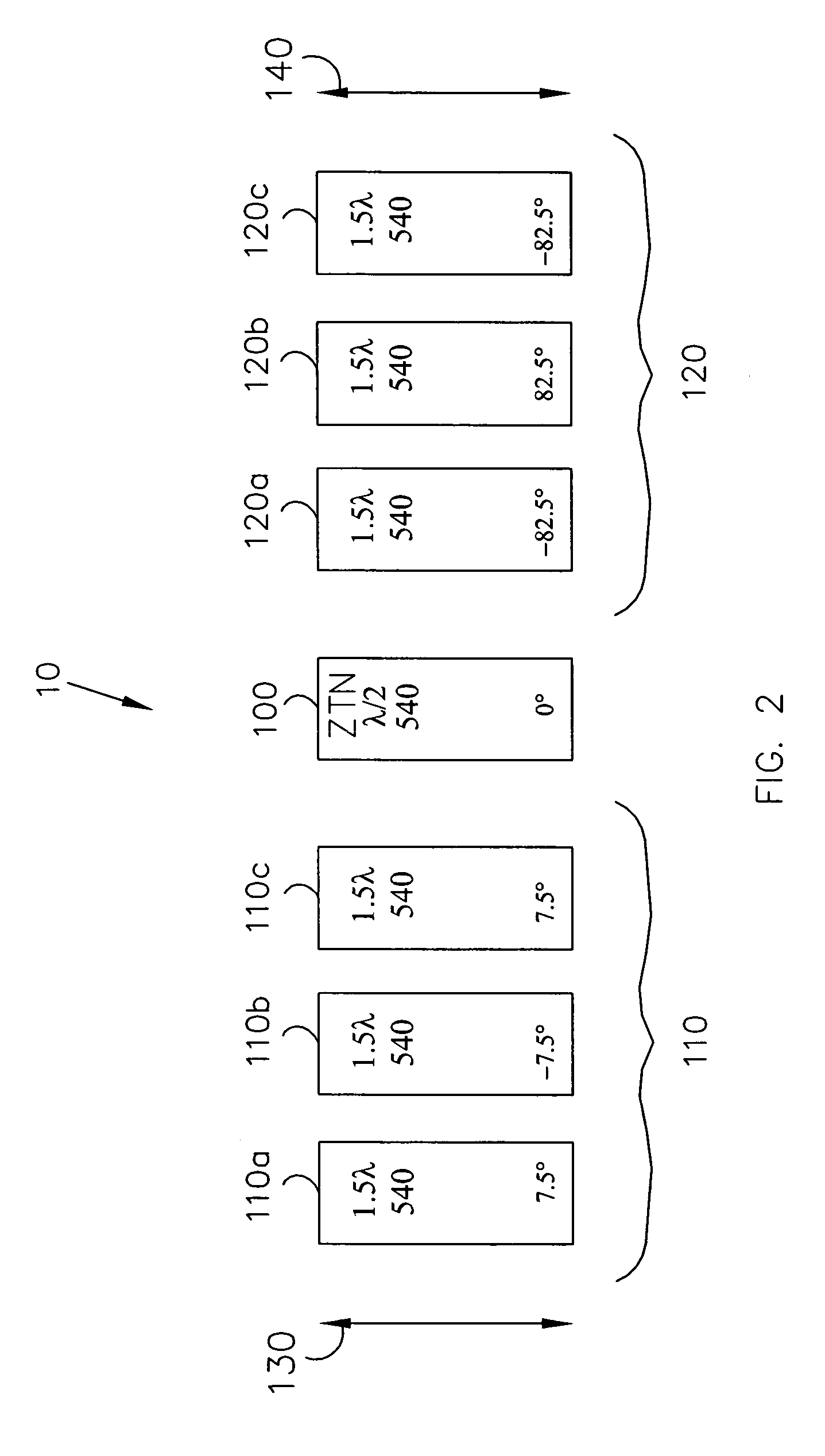Color filters and sequencers using color-selective light modulators
a color filter and color-selective light technology, applied in the field of color selective polarization modulation, can solve the problems of not being able to individually solve the viewer, neither efficient light use, and more hardware intensive techniques, and achieve the effect of high spectral contras
- Summary
- Abstract
- Description
- Claims
- Application Information
AI Technical Summary
Benefits of technology
Problems solved by technology
Method used
Image
Examples
embodiment 2
SA Crossed Stack, 0°-Oriented ZTN LC Modulator, Parallel Polarizer
[0130]FIG. 3 magenta / white M / W color filter similar to the color filter shown in FIG. 2, except that the color filter of FIG. 3 transmits a white output in the SA mode. Like the color filter shown in FIG. 2, the ZTN LC modulator 100 is oriented parallel or perpendicular (π / 2) to the input polarizer 130, so that the modulator 100 will modulate 45° polarized light and pass light that is oriented along the polarization axis of the input, polarizer 130 unchanged.
[0131] The first retarder stack 110 comprises individual retarder films 210a, 210b and 210c oriented at 7.5°, −7.5°, and 7.5°, respectively, with respect to the input polarizer 130. The second retarder stack 120 comprises individual retarder films 220a, 220b and 220c oriented at 82.5°, −82.5° and 82.5°, respectively, with respect to the input polarizer 130. The individual retarder films in the first and second retarder stacks 110 and 120 are 1.5-wave retarders i...
embodiment 3
SO Crossed-Stack, π / 4-Oriented ZTN LC Modulator, Crossed Polarizer
[0134]FIG. 4 shows another embodiment of a color filter with a magenta / white output. Like the embodiments shown in FIGS. 2 and 3, the input and exit polarizers 130 and 140 are oriented parallel with respect to each other. However, the ZTN LC half-wave modulator 100 is oriented at the ±π / 4 with respect to the input polarizer 130. Thus, the modulator 100 modulates the polarization of light that is oriented parallel to the polarization axis of the input polarizer 130, and leaves the polarization of light that is oriented at ±π / 4 with respect to the input polarizer 130 unchanged.
[0135] In order to obtain a M / W output like the color filter shown in FIGS. 2 and 3, the first and second retarder stacks 110 and 120 are modified so that they each provide full-wave retardence in the green (140 nanometers). As in the color filter shown in FIG. 2, the first and second retarder stacks 110 and 120 are crossed with respect to each ...
embodiment 4
SA Crossed-Stack, π / 4-Oriented ZTN LC Modulator, Crossed Polarizer
[0137]FIG. 5 shows another embodiment of a CSLM 10 similar to the CSLM shown in FIG. 4, except that a white output is achieved in the SA mode. The ZTN LC half-wave modulator 100 reflects the state of polarization, such that the input polarization appears to be oriented at π / 2, and the first retarder stack 110“appears” to have orientations π / 2−α1, π / 2−α2, . . . π / 2−αN. A SA white state is generated by creating the “appearance” of crossed retarder stacks and parallel polarizers. This is done by orienting the exit polarizer 140 at π / 2, and orienting the individual retarders second retarder stack 120 at −αN, . . . −α1. The resulting structure has first and second retarder stacks 110 and 120 of opposite sign.
[0138] The embodiment shown in FIG. 5, the first retarder stack 110 comprises individual retarders 410a, 410b and 410c, oriented at 22.5°, 75° and −60°, respectively, with respect to the input polarizer 130. The seco...
PUM
| Property | Measurement | Unit |
|---|---|---|
| wavelength | aaaaa | aaaaa |
| wavelength | aaaaa | aaaaa |
| wavelength | aaaaa | aaaaa |
Abstract
Description
Claims
Application Information
 Login to View More
Login to View More - R&D
- Intellectual Property
- Life Sciences
- Materials
- Tech Scout
- Unparalleled Data Quality
- Higher Quality Content
- 60% Fewer Hallucinations
Browse by: Latest US Patents, China's latest patents, Technical Efficacy Thesaurus, Application Domain, Technology Topic, Popular Technical Reports.
© 2025 PatSnap. All rights reserved.Legal|Privacy policy|Modern Slavery Act Transparency Statement|Sitemap|About US| Contact US: help@patsnap.com



